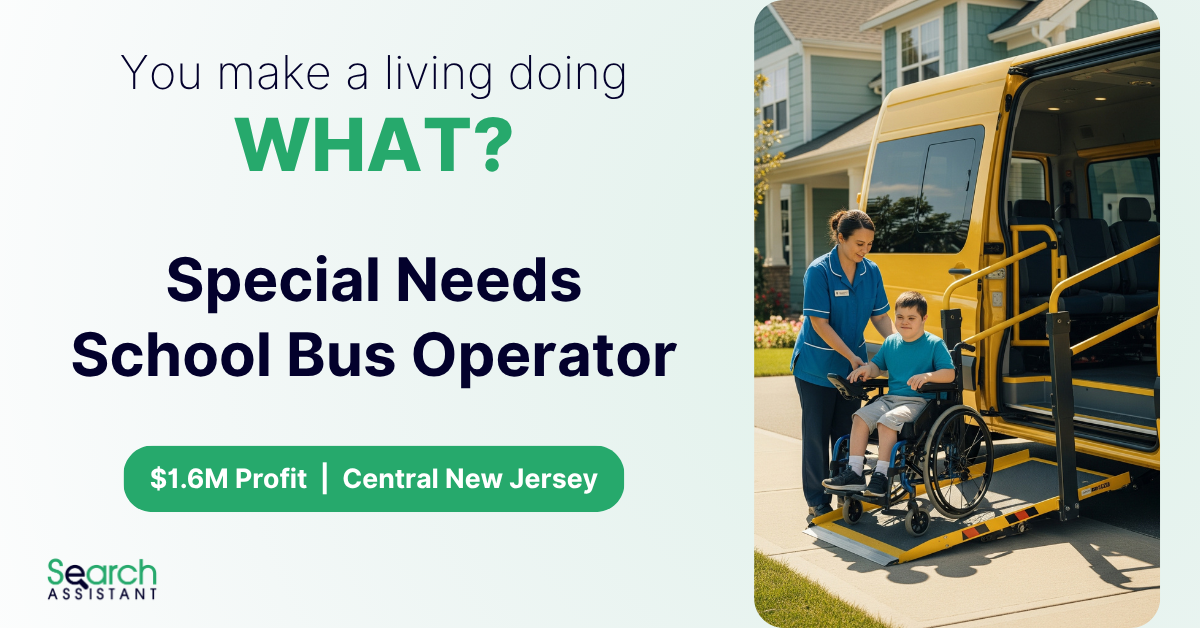Special Needs School Bus Transportation: $1.6M Annual Earnings Business

The Most Defensible Business Model You’ve Never Considered
A school bus transportation company specializing in special needs services has just entered the market with a $6.4 million asking price, generating $1.6 million in annual earnings. While most investors focus on trendy tech startups, this 22-year-old operation represents something far more valuable: a geographic monopoly with government-backed contracts and recession-proof demand.
This opportunity showcases why special needs transportation might be one of the most defensible business models in America—combining regulatory barriers, specialized expertise, and essential public services into a profitable, sustainable enterprise.
The Strategic Advantage: A Moat Built on Mandates and Expertise
This company’s success isn’t accidental; it’s by design. It thrives by combining the stability of government contracts with a high-value, specialized service that few competitors can replicate.
- Government-Backed Contracts: The business operates on multi-year contracts (typically 3-5 years) with public school districts, providing highly predictable, recurring revenue. Incumbent operators with a strong performance record have a significant advantage in contract renewals.
- The Special Needs Premium: The core of the business is its focus on special needs students. This service is not a commodity; it’s a legal necessity for school districts. This allows the company to command premium pricing that is
150-300%higher than standard bus routes due to the need for:- Specialized Equipment: Wheelchair lifts, safety harnesses, and modified seating.
- Highly Trained Staff: Drivers and aides with certifications and training to handle diverse student needs.
- Complex Logistics: Individualized, door-to-door routing and enhanced safety protocols.
This focus creates high switching costs for school districts, which prioritize service continuity and quality over price when dealing with their most vulnerable students.
Financial and Operational Highlights
The business model translates directly into impressive and stable financial performance.
- Asking Price:
$6.4 million - Annual Earnings (SDE):
$1.6 million - Valuation Multiple:
4.0x(A reasonable multiple for a transportation business with significant competitive advantages)
A key operational asset is the company’s in-house mechanics shop. This integrated facility provides a significant competitive edge by:
- Reducing Costs: Saving over
$5,000per bus annually compared to outsourcing maintenance. - Minimizing Downtime: Ensuring fleet reliability and rapid repairs.
- Generating Revenue: Servicing vehicles for other local fleet operators.
Key Considerations and Growth Path
While highly defensible, the industry has challenges that a new owner must manage. The opportunity for growth, however, is clear and actionable.
Risk Factors
- Driver Shortage: Like the entire industry, the business faces a national driver shortage. It mitigates this with competitive compensation and a strong local reputation.
- Electric Vehicle (EV) Transition: Federal mandates are pushing the transition to more expensive electric buses (
$250,000+per vehicle). This presents a capital planning challenge but also an opportunity to secure grants and win contracts with environmentally-focused districts. - Budget Pressures: Public school districts always face budget scrutiny. However, special needs transportation is protected by federal law (IDEA Act), making it one of the last services to be cut.
Strategic Growth Opportunities
A new owner can build on the company’s 22-year foundation by:
- Expanding Geographically to adjacent, underserved school districts.
- Adding New Service Lines, such as charter services for field trips, summer camps, or private schools.
- Serving Adult Transportation Needs for senior centers and disability programs.
- Integrating Technology like route optimization software and parent communication apps to improve efficiency and service.
Conclusion: A Route to Stable Returns
This school bus business offers a rare combination of stable, government-backed revenue and high-margin, specialized services. Its $1.6 million in annual earnings are protected by significant barriers to entry, including high capital costs, specialized expertise, and deep-rooted community relationships.
For an investor seeking a recession-resistant business with predictable cash flow and a clear path for growth, this operation provides a durable competitive advantage in an essential market. It may not be a flashy tech company, but it offers something more valuable: a fundamental service that communities depend on every single day.